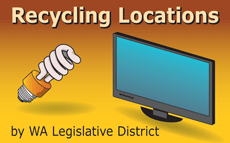Electronics Factsheets & Guides
 Electronic product stewardship: E-Cycle Washington (PDF)
Electronic product stewardship: E-Cycle Washington (PDF)
Washington's electronics stewardship program has recycled over 385 million pounds of electronics, from 300 collection sites, 2009-2018. NWPSC handout, October 2018
E-Cycle Washington Turns 5 (PDF)
In operation since January 2009, E-Cycle Washington commemorated its fifth year with this infographic (PDF) depiction of the 200 million pounds of computers, TVs, and monitors that have been recycled, 13 million pounds of lead, 330 collection sites statewide, and 125 jobs created.
Designing an Effective Electronics Recycling Program: Lessons Learned from Existing State Programs (PDF)
Product Stewardship Institute, 2012. Summary of variations among the 25 existing electronics stewardship laws, impacts on the amount of material collected, materials management, program efficiency, and the administrative burden on government.
 The Northwest Product Stewardship Council has produced a series of fact sheets highlighting the initial results of the E-Cycle Washington Program.
The Northwest Product Stewardship Council has produced a series of fact sheets highlighting the initial results of the E-Cycle Washington Program.
- E-Cycle Washington is a "smash hit" (PDF file, 672KB), this factsheet provides a quick look at the accomplishments and benefits of the first two years of E-Cycle Washington. October 2011.
- Electronics Recycling in Washington: A Product Stewardship Solution (PDF file, 176KB), provides a state-wide look at the accomplishments of the first year (2009) of the E-Cycle Washington program. February 2010.
- E-Cycle Washington Profile: Legislative District 2 (PDF file, 804KB) provides an overview of the program benefits to the counties of Pierce and Thurston.
- E-Cycle Washington Profile: Legislative District 12 (PDF file, 1.28MB) provides an overview of the program benefits to the counties of Chelan, Douglas, Grant and Okanogan.
- E-Cycle Washington Profile: Legislative District 19 (PDF file, 709KB) provides an overview of the program benefits to the counties of Grays Harbor and Pacific.
- E-Cycle Washington Profile: Legislative District 24 (PDF file, 948KB) provides an overview of the program benefits to the counties of Clallam, Grays Harbor and Jefferson.
- E-Cycle Washington Profile: Legislative District 35 (PDF file, 1.03MB) provides an overview of the program benefits to the counties of Grays Harbor, Kitsap, Mason, and Thurston.
- E-Cycle Washington Profile: Legislative District 42 (PDF file, 646KB) provides an overview of the program benefits to Whatcom County.
- E-Cycle Washington Profile: Legislative District 49 (PDF file, 395KB) provides an overview of the program benefits to Clark County.
- E-Cycle Washington Profile: King County (PDF file, 753KB) provides an overview of the program benefits to King County.
- E-Cycle Washington Profile: Spokane County (PDF file, 387KB) provides an overview of the program benefits to Spokane County legislative districts 3, 4, 6, 7 and 9.
- E-Cycle Washington Profile: Snohomish County (PDF file, 905KB) provides an overview of the program benefits to Snohomish County.
 NWPSC Electronics Subcommittee Issue Paper (PDF file, 39KB).
NWPSC Electronics Subcommittee Issue Paper (PDF file, 39KB).
Northwest Product Stewardship Council. 2010.
California Integrated Waste Management Board's Procurement Guidelines.
California Integrated Waste Management Board. June 13, 2008. Links to documents outlining guidelines for California State agency staff involved in purchasing, using or managing electronic equipment.
 NWPSC Bulletin Vol 3, Issue 1: The Rechargeable Battery Recycling Corporation (RBRC) (PDF file, 120KB).
NWPSC Bulletin Vol 3, Issue 1: The Rechargeable Battery Recycling Corporation (RBRC) (PDF file, 120KB).
Northwest Product Stewardship Council. January 2004.
Environmentally Preferable Procurement Guidelines for Information Technology (IT) Equipment in Health Care.
Health Care Without Harm and the Computer TakeBack Campaign. February 12, 2004.
- Part I: The Issue (PDF file, 110KB)
- Part II: Procurement Matrix for Original Equipment Manufacturers & Vendors (PDF file, 110KB).
- Part III: Post Contract Reporting Requirements for Continual Improvement (PDF file, 98KB
Front-end Financing (FEF) Scenarios (PDF file, 115KB).
Snohomish County Solid Waste Management Division. January 20, 2004. A 12-page guide to financing scenarios for producer responsibility programs.
Front-end Financing (FEF) Scenarios for the Collection/Recycling of Electronic Products (PDF file, 115KB).
Snohomish County Solid Waste Management Division. 2004.
- Chart: Advance Recovery Fee (PDF file, 191KB)
- Chart: Extended Producer Responsibility System (PDF file, 191KB)
- Chart: Hybrid System Proposed in Washington's E-waste Legislation (PDF file, 495KB)
- Chart: End of Life Fees System Chart (PDF file, 495KB)
Recommendations for Electronics Handling for School Districts, Cities and Towns in Snohomish County (PDF file, 81KB).
Snohomish County Solid Waste Management Division. June 6, 2003.
Citizen's Guide to Producer Responsibility: Who is taking out the electronic trash? (PDF file, 266KB)
Washington Citizens for Resource Conservation. February 2003.
Take it Back Network: Packaging and Transporting Electronics (PDF file, 1.1MB)
Snohomish County Solid Waste Management Division. February 2003. Tips and guidlines for proper handling of electronic products for recycling at stores and businesses.
Setting Up & Operating Electronics Recycling/Reuse Programs: A Manual for Municipalities & Counties.
Northeast Recycling Council, Inc. March 2002.
 NWPSC Bulletin Vol. 1, Issue 1: Governments Saddled with Electronic Scrap (PDF file, 426KB).
NWPSC Bulletin Vol. 1, Issue 1: Governments Saddled with Electronic Scrap (PDF file, 426KB).
Northwest Product Stewardship Council. November 2001.
 Considerations for Local Communities Related to Collection of Used Electronic Products (PDF file, 53KB).
Considerations for Local Communities Related to Collection of Used Electronic Products (PDF file, 53KB).
Northwest Product Stewardship Council.
 NWPSC Policymakers Bulletin - Governments Saddled With Electronic Scrap
NWPSC Policymakers Bulletin - Governments Saddled With Electronic Scrap
This Policymakers' Bulletin (PDF file, 426KB, November 2001) outlines the problems of electronic scrap and how they affect local governments. The bulletin describes how product stewardship practices can save local governments money on waste management and describes how electronics product manufacturers can share the burden. It also provides a list of actions that local governments can take to make the shift from current waste management practices to product stewardship practices.
